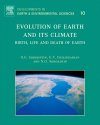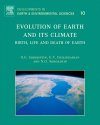By: OG Sorokhtin(Author), GV Chilingarian(Author), NO Sorokhtin(Author), Lee C Gerhard(Foreword By)
576 pages, illustrations, tables
![Evolution of Earth and its Climate Evolution of Earth and its Climate]()
Click to have a closer look
About this book
Contents
Customer reviews
Related titles
About this book
The book reviews the current physical theory of Earth's global evolution, its origin, structure and composition, the process of Earth's core formation, Earth's energy, and the nature of its tectonomagnetic activity. Evolution of Earth and its Climate also deals with the origin of the Moon and its influence on our planet's evolution. Based on the integral positions of this theory, the book analyzes the issues of the origin of the hydrosphere and atmosphere, and the conception and evolution of life on Earth. Evolution of Earth and its Climate also reviews the adiabatic theory of the greenhouse effect developed by the authors, and the effects of nitrogen-consuming bacteria and of periodic changes in the precession angle on its climate. In particular, these effects cause the onset and periodicity of ice ages and a significant climate warming during the periods of supercontinent appearance (like Pangaea in the Mid-Mesozoic).
Contents
Foreword
Introduction
Chapter 1. Major stages and methodology in the evolution of geological concepts
Chapter 2. Structure and composition of modern Earth
Chapter 3. Origin of Earth, its past and future
Chapter 4. Process of Earth’s core separation
Chapter 5. Earth energetics
Chapter 6. Earth's tectonic activity and its nature
Chapter 7. Evolution of the crust-formation processes in Earth's history
Chapter 8. Lithospheric plate tectonics in Early Proterozoic and Phanerozoic
Chapter 9. Continental drift in Earth's geological history
Chapter 10. Major patterns of economic deposit concentration within Earth's crust
Chapter 11. Hydrosphere: the patterns of its origin and evolution
Chapter 12. Atmosphere: origin and physicochemical aspects of evolution
Chapter 13. Adiabatic theory of the greenhouse effect
Chapter 14. Evolution of Earth’s global climate
Chapter 15. Origin and major stages of life evolution on Earth
Conclusions
References
Customer Reviews
By: OG Sorokhtin(Author), GV Chilingarian(Author), NO Sorokhtin(Author), Lee C Gerhard(Foreword By)
576 pages, illustrations, tables




































